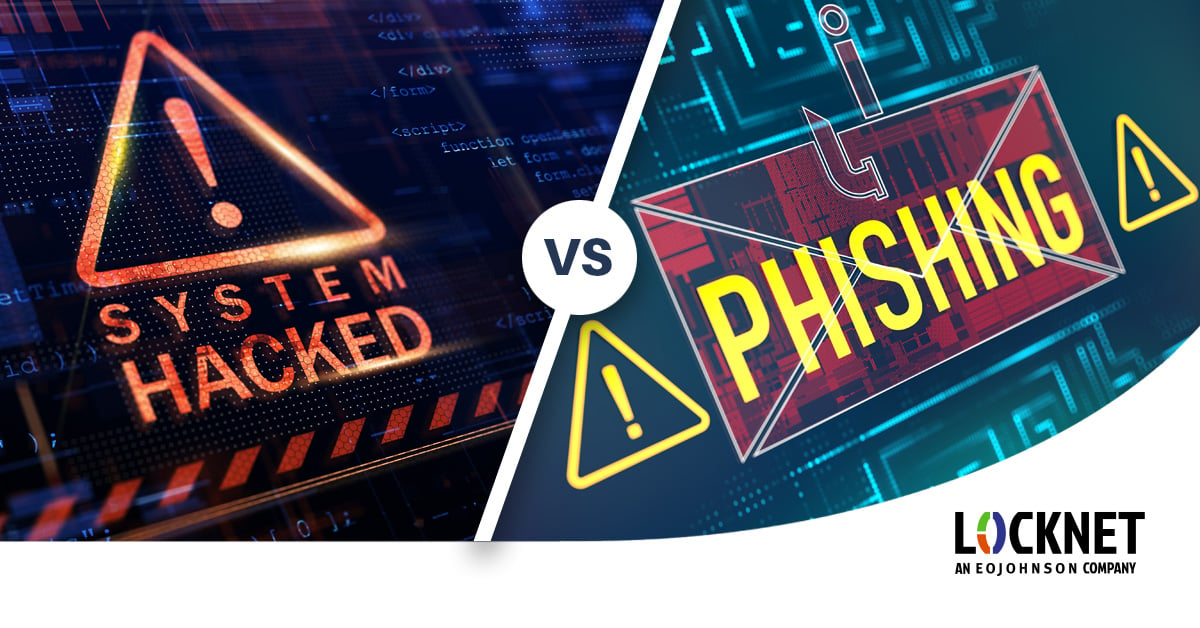Industries We Serve
World Class IT Support & Service
Real People. Right Now.
About Locknet® IT Services
From the first hello, the Locknet® team is dedicated to serving you and your needs.
Real People. Right Now.
From the first hello, the Locknet® team is dedicated to serving you and your needs.


Updated May 19, 2025
In today's technological landscape, where almost everything is connected to the internet, cybersecurity has become a significant concern. Two terms that often come up in discussions about cybersecurity are hacking and phishing. Although these terms are sometimes used interchangeably, they refer to different activities. We’ll shed some light on the difference between hacking and phishing, two of the most common cyber threats.
Hacking is the act of illicitly gaining information that is not authorized. By gaining access to an account or network, a hacker can use it for personal gains. Hackers can target various systems, including computers, networks, websites, and even individual user accounts.
Hackers fall into three categories.
Hacking methods can range from simple password guessing to sophisticated techniques like SQL injection. Regardless of the method used, the primary goal of hacking is usually to gain unauthorized access or control over a system or network.
Phishing means pretending to be a trustworthy source to steal sensitive information such as a username, password, social security number, or credit card number. Phishing is typically done using email or the cloning of a legitimate website to cast a wide net and then narrow-in on susceptible victims.
Three common types of phishing:
Hacking and phishing are related in that they are both ways of obtaining information, but they differ in how they do it. A phish, which ultimately can become a hack, occurs when a user is baited with an email, phone call, or text and the user is tricked into providing personal information. Phishing attacks are often spoofs of trusted sources or brands. While the victim has been tricked into providing the information, they technically have done so voluntarily.
With hacking, information is accessed involuntarily. The cybercriminal takes over a computer system through brute force or more sophisticated methods to access sensitive data.
Another key difference is the target of these attacks. While hacking often targets systems or networks, phishing primarily targets individuals. However, it's worth noting that these two methods can be used together. For instance, a hacker could use a phishing attack to obtain an individual's login credentials and then use these to hack into a system or network.
Understanding the nuances between hacking and phishing is just the first step in protecting yourself against these cyber threats. It's also important to take proactive measures to enhance your cybersecurity.
Employing a proactive defense strategy is vital, with employee education playing a pivotal role. Even with robust security, educating employees on phishing threats and cybersecurity awareness is crucial to safeguarding networks, data, and reputation. Locknet Managed IT offers complete IT and cybersecurity support for your business, including an array of solutions to mitigate vulnerabilities:
Empower your team to recognize the telltale signs of a phishing email. Share this handy infographic featuring 7 quick and easy tips—perfect for keeping by your organization’s computers. Download it now and arm yourself with essential knowledge to stay secure!
While both hacking and phishing pose significant threats in our increasingly digital world, they are different in terms of their approach, execution, and target. By understanding these differences between hacking and phishing, and then taking appropriate security measures, you can significantly reduce the risk of falling victim to these cyber-attacks.
A security risk assessment from Locknet Managed IT is a great place to start reducing your risk. Our team will take a comprehensive and thorough approach to assessing your current risk.
Our security risk assessment is an integral part of our comprehensive managed IT services, aimed at safeguarding your organization from cyber threats. By partnering with us, you gain access to a thorough evaluation of your current security posture, identification of vulnerabilities, and a roadmap with strategies to mitigate risks. Contact us to get started on a security assessment of your organization.
Cybersecurity

Onalaska, WI Waterloo, IA Wausau, WI Eau Claire, WI Burnsville, MN
You are now leaving locknetmanagedit.com. Please check the privacy policy of the site you are visiting.